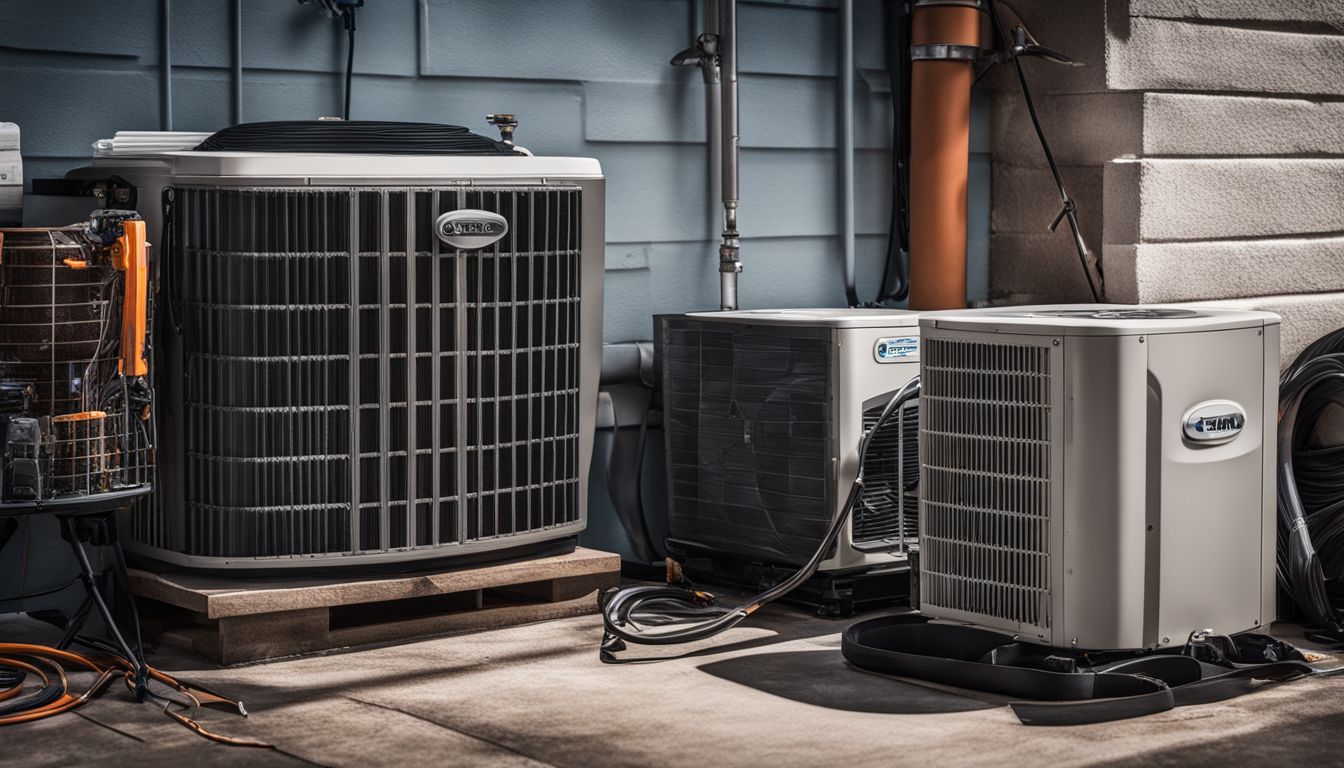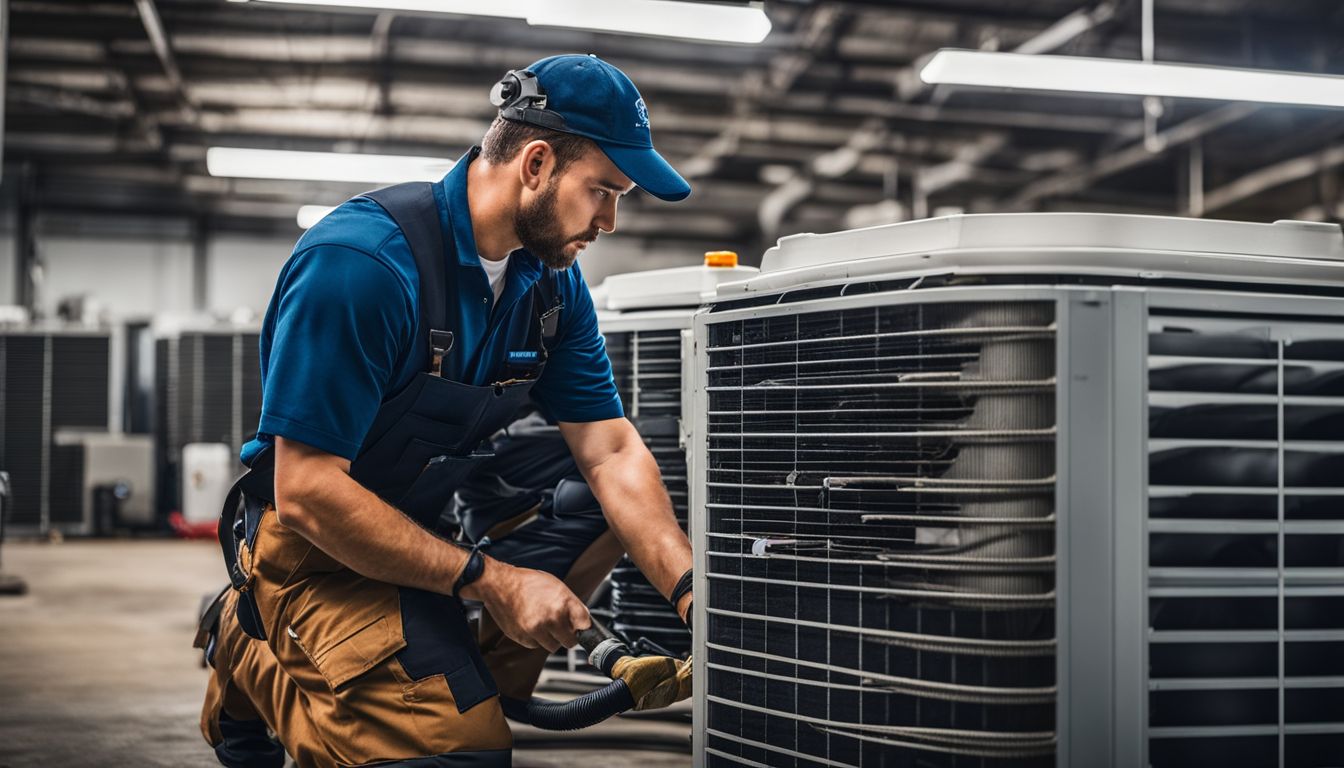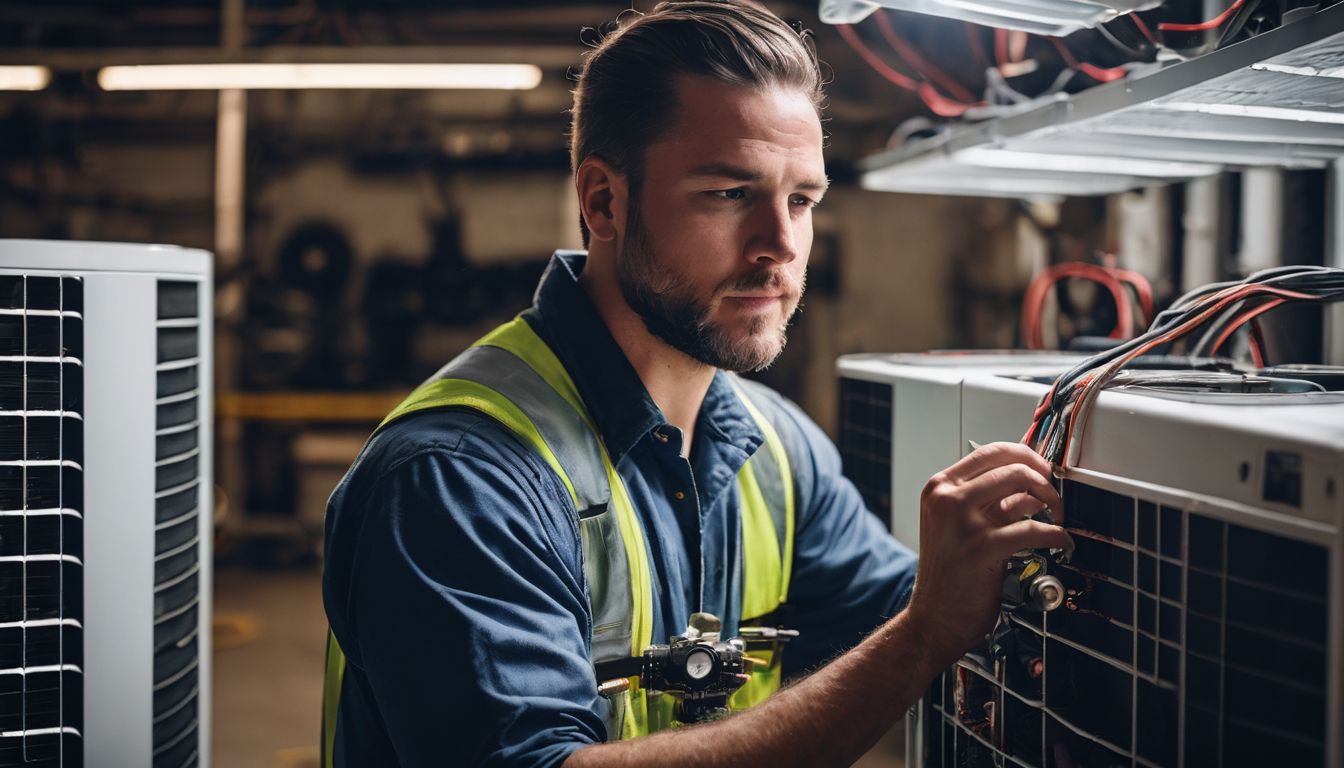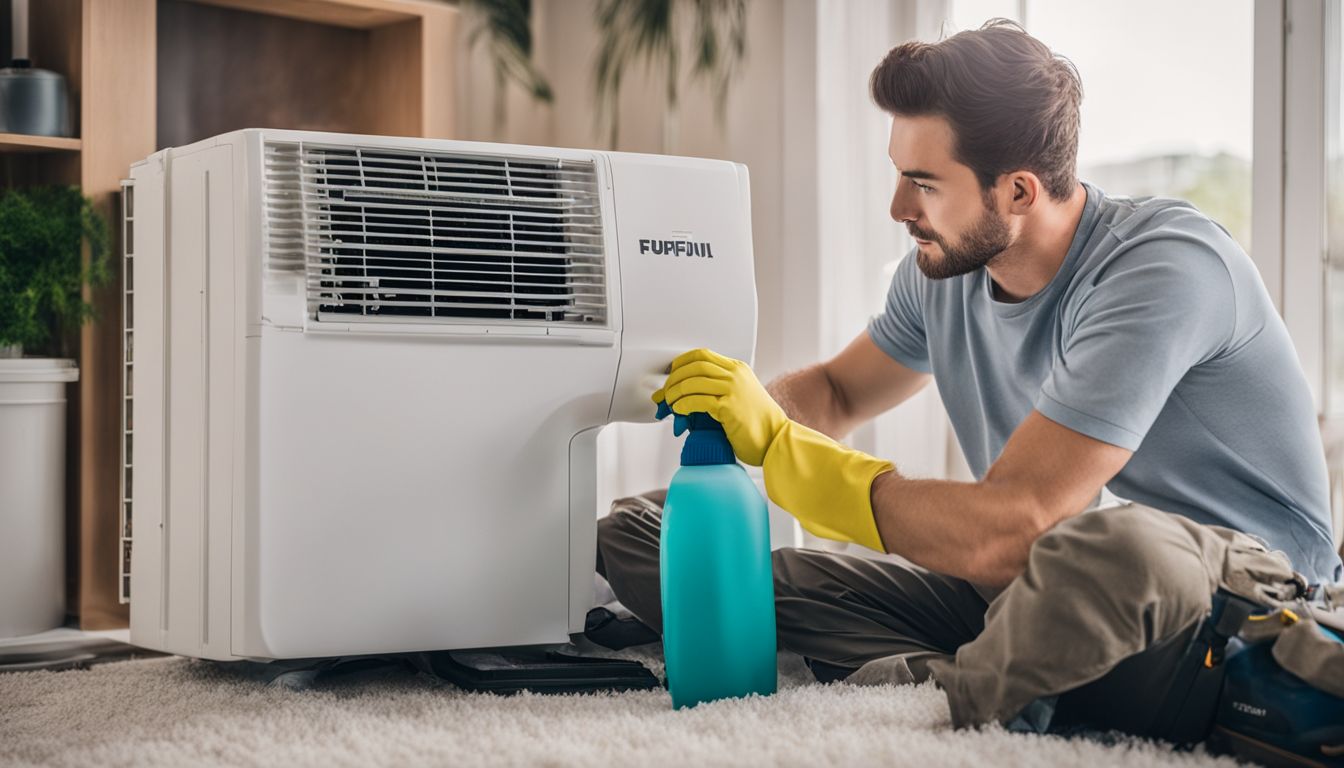Feeling the heat at home even when your air conditioner is running can be quite frustrating. It’s crucial to know that the secret to a cool and comfortable indoor environment lies within your AC’s coils.
This article will unravel the mysteries of evaporator and condenser coils, giving you insights into their upkeep for optimal performance. Read on to ensure those sweltering days are effortlessly chilled.
Understanding the Evaporator Coil in an Air Conditioner
The evaporator coil is a pivotal component in any air conditioning unit, silently and efficiently absorbing heat from indoor air to keep your environment comfortably cool. Its role in the HVAC system is crucial for transforming humid, warm interior conditions into the crisp, refreshing atmosphere we often take for granted during hot days.
What is an Evaporator Coil?
An evaporator coil is a vital component of your air conditioning system, situated inside or very close to the furnace. It’s built similarly to a car radiator, with coils that are key in heat absorption during the cooling process.
This coil holds the refrigerant that draws warmth from indoor air as it blows over its surface.
During operation, warm air from inside your home passes across this cold coil. The refrigerant captures the heat and steadily transforms from liquid to gas, a part of what’s known as latent heat transfer.
In essence, this is where the magic happens: heat removal turns warm indoor air into cool comfort for your living spaces. Regular maintenance keeps this pivotal piece working efficiently, ensuring consistent and enjoyable climate control at home.
Location and Function of the Evaporator Coil
Tucked away inside the air handler, the evaporator coil serves as a hero in your home’s battle against heat. This crucial component cradles the refrigerant and is responsible for absorbing warmth from the indoor air.
As warm air passes over these chilled coils, heat gets transferred into the refrigerant within, turning it from a liquid state to gas during evaporation.
This transformation allows your air conditioning system to deliver cool and dehumidified air throughout your living space. The coils play an essential part in maintaining comfortable indoor temperatures by initiating the heat exchange process that defines efficient cooling.
It’s here where moisture from hot household air condenses on the cold surface of the coils, stripping humidity and contributing to better overall indoor air quality.
Common Issues with the Evaporator Coil
Dirty evaporator coils are a common headache for anyone relying on their air conditioning systems. The build-up of dirt and debris restricts airflow, meaning your system has to work harder to cool your space, reducing energy efficiency.
Regular coil cleaning is essential but often overlooked until problems arise.
Leaking refrigerant is another issue that can affect the performance of your evaporator coils. Without the correct level of refrigerant, the coil may freeze up or fail to dehumidify the air effectively, leading to uneven cooling and discomfort in your home.
Professional repair is usually needed if you spot signs like ice on the coil or feel less cool air coming from your system.
Understanding the Condenser Coil in an Air Conditioner
At the heart of your air conditioner’s ability to cool lies the condenser coil, a crucial component often located within the outdoor unit. This coil plays an integral role in expelling heat absorbed from indoor air, thus completing the cooling cycle and maintaining your home’s comfort levels.
What is a Condenser Coil?
A condenser coil is a crucial component of your air conditioner or heat pump system, playing an essential role in the cooling process. It’s typically located in the outdoor unit and works tirelessly to release the heat from your indoor spaces into the outside air.
As refrigerant gas passes through this coiled structure, it transforms from its gaseous state to a liquid by shedding its warmth with the help of a fan that blows outdoor air across it.
The design of a condenser coil mirrors that of its partner, the evaporator coil; however, their jobs are completely different. While evaporator coils absorb heat to cool interiors, condenser coils do just the opposite – they get rid of heat.
Together, these two components ensure that your central air conditioning units keep your living environment comfortable by pumping coolant around and transferring heat energy where it’s needed or not needed.
Regular cleaning and HVAC maintenance can significantly enhance both their longevity and efficiency.
Location and Function of the Condenser Coil
In every air conditioner, the condenser coil plays a vital role and is typically situated in the outdoor unit of split systems, or at the back for window units. This allows it to release heat into the outside air effectively.
Central air conditioners rely on a fan within the condenser unit to aid in cooling down hot refrigerant gas as it passes through these coils. The heat exchange process is crucial because it cools down the gas, turning it into a liquid that will be sent back inside to absorb more heat from your home’s interior.
The functionality of this component hinges on its ability to convert refrigerant from a gaseous state to a liquid form by expelling warmth acquired indoors. Ensuring cleanliness is key; debris and dirt can insulate the coil, impeding its capacity to dissipate heat and impairing overall system performance.
To maintain peak operation of your cooling equipment, regular cleaning of copper tubes within these coils is necessary – neglect could lead to refrigerant leaks and costly coil replacement later on.
Common Problems with the Condenser Coil
Condenser coils are crucial in the heat exchange process of your air-conditioner, but they can run into trouble. One frequent issue is leakage, which compromises the cooling efficiency and may demand costly repairs.
As refrigerants escape through tiny holes or cracks, this not only affects performance but can also be harmful to the environment.
Dirt build-up on condenser coils is another headache for homeowners and service technicians alike. Over time, layers of dust and debris hinder heat release, forcing your system to work harder.
This increased strain often results in soaring operating temperatures that can lead to overheating – a precursor to potential system failure. Regular cleaning ensures better energy savings and prolongs the life span of your unit by preventing such complications from arising.
Maintenance Tips for Air Conditioner Coils

Maintaining your air conditioner coils is critical for efficiency and longevity; discover actionable strategies to keep them in peak condition within our guide.
Cleaning the Coils without Removal
Maintaining your air conditioner’s coils is essential for efficient performance, yet it doesn’t always mean you have to remove them. Begin by using a nylon scrub brush to dislodge any large pieces of dirt or debris; start at the top and gently work downwards to prevent bending the delicate fins.
This method protects the coils and ensures you won’t damage any components inside your A/C system.
Technicians often use a shop vac to suck up all that loosened grime from both evaporator and condenser coils. For more stubborn dirt, apply a non-corrosive coil cleaner specially designed for this purpose—it effectively breaks down filth without harming the metal parts.
Once treated with cleaner, spray water onto the condenser coils with a hose, thoroughly flushing out contaminants while keeping everything intact. These routine cleaning steps can significantly improve your unit’s airflow and cooling efficiency without the risk of dismantling sensitive parts within your heating and cooling system.
Signs of Coil Issues
Your air conditioner might be telling you something if it starts blowing warm air instead of keeping your rooms comfortably cool. This could signal that the evaporator coils are having trouble, potentially due to dirt build-up or even damage like cracking or freezing over.
If these vital components don’t work properly, they can’t absorb heat efficiently – and you’ll feel the difference.
Watch out for puddles or damp spots near your indoor unit; this often means that condensation isn’t being managed well, typically because of coil issues. Strange noises and unpleasant odours coming from your AC can also point to problems with the coils, indicating that it’s time for a closer look or professional assistance.
Keep an ear out for any hissing or banging which shouldn’t be part of normal operations – these sounds may suggest coolant system errors related to damaged coils.
Decoding Everyday Cooling Terms
Air conditioners work magic to keep us cool, but understanding the terms that explain their functions can sometimes feel like a foreign language. Let’s unlock these cooling secrets and make sense of what keeps your spaces so comfortably chill.
The evaporator coils are where the real action happens; they take in warm air from your room, pass it over coils containing super-chilled refrigerant, and voila – the air cools down as heat gets absorbed by the refrigerant.
The condenser coil then takes charge by dealing with this heat-absorbed refrigerant. It pumps it outside and releases the captured warmth into the open air, completing an amazing cycle of coolness.
Terms like “high SEER” pop up often too; this stands for Seasonal Energy Efficiency Ratio – basically how well your unit turns electricity into cold air without wasting energy. Knowing about smart thermostats might also come in handy, allowing you to control temperatures effortlessly while saving on bills.
These devices learn your habits and adjust settings accordingly for optimum comfort with maximum efficiency.
Conclusion

Having explored the vital roles of evaporator and condenser coils in air conditioners, we grasp their importance for cooling efficiency. Regularly cleaning these coils contributes significantly to reducing energy consumption and saving on bills.
Remember that well-maintained AC coils can last up to 15 years, ensuring a comfortable indoor environment. Tackling routine maintenance head-on prevents common coil-related issues from escalating into costly repairs.
Optimal performance hinges on understanding your system’s components and caring for them diligently. Embrace these insights to keep your living or working space pleasantly cool throughout the scorching summers ahead.
For a deeper understanding of common terms used in the realm of air conditioning, visit our comprehensive guide on everyday cooling terminology.
FAQs
1. What are air conditioner coils?
Air conditioner coils are key components in your AC unit that help transfer heat. The evaporator coils inside the air handler absorb heat from indoor air, while the condenser coils release it outdoors.
2. Why does my AC have an expansion valve?
The expansion valve controls the flow of coolant to the evaporator coil. It regulates how much coolants turn into a cold gas and cools down air as it passes through the evaporator coils.
3. Do I need to clean my air conditioning evaporator regularly?
Yes, keeping your evaporator clean helps prevent issues like the accumulation of formic acid and volatile organic compounds that can cause corrosion and reduce efficiency.
4. Can dirty coils affect my allergies or asthma?
Absolutely! If your air filter doesn’t catch all allergens, they might stick to the moist surface of your AC’s evaporator coil, leading to poor indoor air quality which can trigger allergies or asthma symptoms.
5. How do Air purifiers work with my home’s HVAC system?
Air purifiers attach to your HVAC system and use filters to trap particles like dust before they reach blower fans or get recirculated by fan coil units throughout your home’s airflow system.
6. Is it important what material my AC’s coils are made from?
Definitely – you want materials with good conductivity but also resistant to corrosion for higher SEER (efficiency) ratings; this ensures better performance over time even when dealing with water vapour or steam during compression cycles.





